Types of Quadrilateral












Types of Quadrilateral
A quadrilateral is a four sided or edges closed plane figure. As it has four edges, it has four corners or the points where the edges meet. These corners are called vertices. The various type of quadrilaterals are:
| 1. Parallelogram: It is quadrilateral in which opposite sides are parallel and equal. | 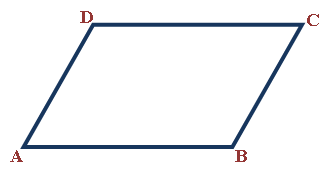 |
| 2. Rectangle: It is a special type of parallelogram in which each angle is a right angle. | 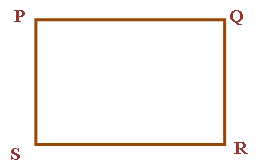 |
| 3. Square: A square is a special type of rectangle in which all the four sides are equal. | 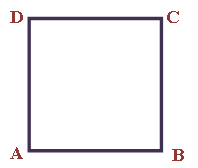 |
| 4. Rhombus: It is a parallelogram in which all the four sides are equal, but the angles are not right angles. The diagonals bisect each other at right angles. | 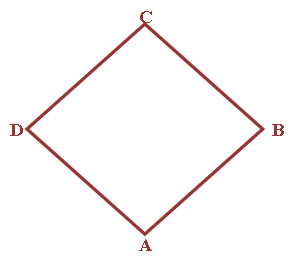 |
|
5. Trapezium: It is a quadrilateral in which one pair of opposite sides is parallel and other is non parallel. If the non-parallel sides are equal then it is known as isosceles trapezium because it is made from an isosceles triangle by cutting the equal sides with a line parallel to the third side. |
 |
|
6. Kite: It is a quadrilateral in which the four sides can be grouped into two pairs of equal sides that are adjacent to each other. The diagonals of a kite intersect perpendicularly. |
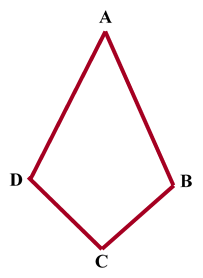 |
Quadrilaterals can also be classified as:
|
1. Convex. Quadrilaterals: It is defined as a quadrilateral in which all its interior angles less than 180°. Or we can say that all the vertices will be bulging outwards i.e. away from the interior of the shape. Both the diagonals will be inside the quadrilateral |
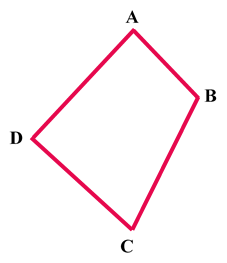 |
|
2. Concave Quadrilaterals. It is defined as a quadrilateral in which one interior angle is more than 180°. Or we can say that one of the vertices will be pushed inwards i.e. towards the interior of the shape. Both the diagonals will not be inside the quadrilateral |
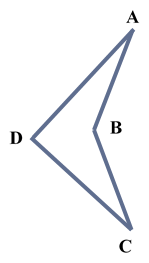 |
|
3. Self-Intersecting Quadrilaterals: They are complex quadrilaterals also called crossed quadrilateral. In these quadrilaterals one of the opposite pair of sides are intersecting with each other. |
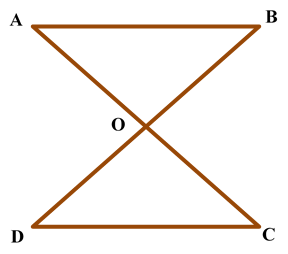 |
Important Terminologies:
|
Adjacent or Consecutive Sides: Two sides of a quadrilateral which have a common vertex are called Adjacent Sides.For example AB and BC as they have common vertex. Opposite Sides: The two sides of a quadrilateral which do not have a common vertex are called opposite sides. For example AB and CD Consecutive Angles: The angles of a quadrilateral which have one common arm are consecutive angles.For example Opposite Angles: The angles of a quadrilateral which do not have any common arm are consecutive angles. .For example |
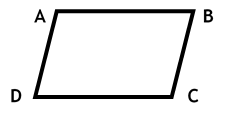 |
A quadrilateral which has exactly one pair of parallel sides is called ___________________ | |||
| Right Option : C | |||
| View Explanation | |||
Which of the following shapes represent a Square? | |||
| Right Option : A | |||
| View Explanation | |||
A rhombus can be a ________________________ | |||
| Right Option : D | |||
| View Explanation | |||
Students / Parents Reviews [20]
When I have not joined Abhyas Academy, my skills of solving maths problems were not clear. But, after joining it, my skills have been developed and my concepts of science and SST are very well. I also came to know about other subjects such as vedic maths and reasoning.

Sharandeep Singh
7thMy experience with Abhyas is very good. I have learnt many things here like vedic maths and reasoning also. Teachers here first take our doubts and then there are assignments to verify our weak points.

Shivam Rana
7thOne of the best institutes to develope a child interest in studies.Provides SST and English knowledge also unlike other institutes. Teachers are co operative and friendly online tests andPPT develope practical knowledge also.

Aman Kumar Shrivastava
10thAbhyas is a complete education Institute. Here extreme care is taken by teacher with the help of regular exam. Extra classes also conducted by the institute, if the student is weak.

Om Umang
10thIt was good as the experience because as we had come here we had been improved in a such envirnment created here.Extra is taught which is beneficial for future.

Eshan Arora
8thAbhyas is good institution and a innovative institute also. It is a good platform of beginners.Due to Abhyas,he has got knoweledge about reasoning and confidence.My son has improved his vocabulary because of Abhyas.Teacher have very friendly atmosphere also.

Manish Kumar
10thMy experience with Abhyas Academy has been very good. When I was not in Abhyas whenever teacher ask questions I could not speak it confidently but when I came in Abhyas, my speaking skills developed and now I am the first one to give the answer of teachers question.

Upmanyu Sharma
7thAbhyas academy is great place to learn. I have learnt a lot here they have finished my fear of not answering.It has created a habit of self studying in me.The teachers here are very supportive and helpful. Earlier my maths and science was good but now it has been much better than before.

Barkha Arora
10thThird consective year,my ward is in Abhyas with nice experience of admin and transport support.Educational standard of the institute recumbent at satisfactory level. One thing would live to bring in notice that last year study books was distributed after half of the session was over,though study ...

Ayan Ghosh
8thA marvelous experience with Abhyas. I am glad to share that my ward has achieved more than enough at the Ambala ABHYAS centre. Years have passed on and more and more he has gained. May the centre flourish and develop day by day by the grace of God.

Archit Segal
7thAbhyas institute is one of the best coaching institute in the vicinity of Ambala cantt.The institute provides good and quality education to the students.The teachers are well experienced and are very helpful in solving the problems. The major advantages of the institute is extra classes for weak...

Shreya Shrivastava
8thWe started with lot of hope that Abhyas will help in better understnding of complex topics of highers classes. we are not disappointed with the progress our child has made after attending Abhyas. Though need to mention that we expected a lot more. On a scale of 1-10, we would give may be 7.

Manya
8thUsually we see institutes offering objective based learning which usually causes a lag behind in subjective examinations which is the pattern followed by schools. I think it is really a work of planning to make us students grab the advantages of modes of examination, Objective Subjective and Onli...

Anika Saxena
8thMy experience with Abhyas academy is very nice or it can be said wonderful. I have been studying here from seven class. I have been completing my journey of three years. I am tinking that I should join Abhyas Academy in tenth class as I am seeing much improvement in Maths and English

Hridey Preet
9thIt has a great methodology. Students here can get analysis to their test quickly.We can learn easily through PPTs and the testing methods are good. We know that where we have to practice

Barkha Arora
10thThe experience was nice. I studied here for three years and saw a tremendous change in myself. I started liking subjects like English and SST which earlier I ran from. Extra knowledge gave me confidence to overcome competitive exams. One of the best institutes for secondary education.

Aman Kumar Shrivastava
10thIn terms of methodology I want to say that institute provides expert guidence and results oriented monitering supplements by requsite study material along with regular tests which help the students to improve their education skills.The techniques of providing education helps the students to asses...

Aman Kumar Shrivastava
10thIt was a good experience with Abhyas Academy. I even faced problems in starting but slowly and steadily overcomed. Especially reasoning classes helped me a lot.

Cheshta
10thBeing a parent, I saw my daughter improvement in her studies by seeing a good result in all day to day compititive exam TMO, NSO, IEO etc and as well as studies. I have got a fruitful result from my daughter.

Prisha Gupta
8thAbhyas Methodology is very good. It is based on according to student and each child manages accordingly to its properly. Methodology has improved the abilities of students to shine them in future.
